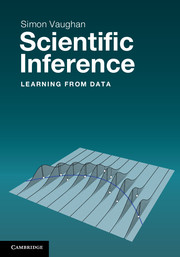Book contents
- Frontmatter
- Dedication
- Contents
- For the student
- For the instructor
- 1 Science and statistical data analysis
- 2 Statistical summaries of data
- 3 Simple statistical inferences
- 4 Probability theory
- 5 Random variables
- 6 Estimation and maximum likelihood
- 7 Significance tests and confidence intervals
- 8 Monte Carlo methods
- Appendix A Getting started with statistical computation
- Appendix B Data case studies
- Appendix C Combinations and permutations
- Appendix D More on confidence intervals
- Appendix E Glossary
- Appendix F Notation
- References
- Index
3 - Simple statistical inferences
Published online by Cambridge University Press: 05 June 2014
- Frontmatter
- Dedication
- Contents
- For the student
- For the instructor
- 1 Science and statistical data analysis
- 2 Statistical summaries of data
- 3 Simple statistical inferences
- 4 Probability theory
- 5 Random variables
- 6 Estimation and maximum likelihood
- 7 Significance tests and confidence intervals
- 8 Monte Carlo methods
- Appendix A Getting started with statistical computation
- Appendix B Data case studies
- Appendix C Combinations and permutations
- Appendix D More on confidence intervals
- Appendix E Glossary
- Appendix F Notation
- References
- Index
Summary
Everything should be made as simple as possible, but not simpler.
Attributed to EinsteinWe can use what we have learnt to start making some inferences about data. Maybe we have collected measurements of a quantity and wish to see if these are consistent with some theoretical expectation. We don't just want to compute the sample mean but to compare it with something else. Perhaps we have two samples, taken under different conditions (such as a ‘treatment’ and ‘control’ group) and wish to see if their mean responses differ. Another very common situation is that we have measurements of some response (y) taken at different values of some explanatory variable (x) and wish to quantify the way that y responds. We can go some way to getting useful inferences out of such data using numerical and graphical summaries (Chapter 2). These can be refined once we have studied some probability theory (Chapters 4 and 5).
Inference about the mean of a sample
We take repeated measurements of a single quantity, or measure the same quantity for each member of a finite sample, and wish to discover whether these data are consistent with a predetermined theoretical value. We want to know if our sample is consistent with being randomly drawn from a theoretical population, with some particular population mean. As an example, let's consider the first ‘experiment’ (batch of 20 runs) of Michelson's dataset (see Appendix B, section B.1).
- Type
- Chapter
- Information
- Scientific InferenceLearning from Data, pp. 46 - 63Publisher: Cambridge University PressPrint publication year: 2013



